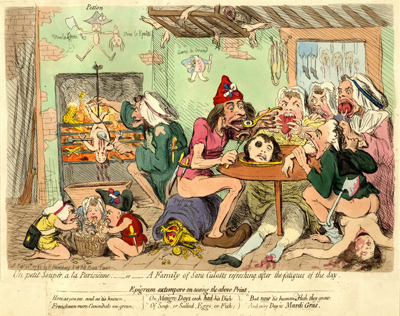Un Petit Souper a la Parisienne. . .
As Burke had predicted, by September 1792 the revolution in France was spinning wildly out of control. Fearing traitors from within and invaders from without, the radical factions within the French government were growing ever more paranoid and violent. Suspecting that foreign armies led by Charles Frederick, the Duke of Brunswick, would join with Royalist forces to liberate the many recent inmates of Parisian prisons and use them to help take back Paris, the French National Guard launched a series of attacks on the prisons in early September 1792, removing and, in many cases, immediately executing the inmates. Their numbers included petty criminals, political prisoners, and a number of priests who refused to forswear allegiance to the Pope as the French civil authorities now demanded.

© Trustees of the British Museum
The British press was horrified at the reports of the atrocities committed in what was later called the " September Massacres," which included reports of cannibalism by some of the starving Parisians. Here is a supposed eye witness report which appeared in the London Evening Mail of September 7th–10th.
The streets this morning exhibited a spectacle of the mangled bodies and heads of the priests who were yesterday massacred. Several have passed my window, and the multitude who follow this cannibal feast, are singing choruses as expressive of their joy.
And another from the St. James Chronicle or British Evening Post of September 11th.
A gentleman who left Paris yesterday week assures us that the terrible accounts detailed in the London Papers of the dreadful cruelties transacted in that unfortunate capital, so far from being exaggerated, come very short of the truth. That 6000 people were absolutely murdered by one Jury of Twelve, sitting in one of the prisons. That three large wagons were employed without intermission for six and thirty hours, in carrying the dead bodies out of Paris, and throwing them promiscuously into a pit dug for the purpose.
Perhaps because of his strict Moravian upbringing, Gillray never had doubts about the essential depravity of human nature. And based on the already horrific reports coming out of France, Gillray began to create a succession of images, including Un Petit Souper a la Parisienne. . . and A View in Perspective. The Zenith of French Glory. . . which has come to define revolutionary excess for the British public both then and now.
In Un Petit Souper. . ., a poor extended family of French revolutionaries dines upon what appears to be the bodies of a corresponding family of aristocrats. Gillray, as he was wont to do, plays upon the term "sans-culottes" by representing the revolutionaries literally without breeches as opposed to the dead gentleman beneath the table with silk stockings, leather pump, and knee breeches. The central revolutionary man with the identifying bonnet rouge and tri-color cockade is about to eat the eye ball and ear from the dead man's head on the gold platter before him. The two women beside him feast upon his heart and kidneys(?).
The other sans-culotte (with the axe in his belt) is sitting upon the bare breast of a woman who may be the wife of the gentleman. Like him, she has had her throat cut, and her somewhat delicate right arm and hand (appropriately cut off from the picture) is about to be eaten.
On the opposite side of the room, several revolutionary chidren greedily eat with their hands from a basket of entrails while the corresponding aristocratic child (just above them) is being roasted and basted for a future meal. Further supplies of human flesh can be seen on a rack suspended from the ceiling and outside the doorway.
On the back wall, ironically poised between the words "Vive la Liberte" and "Vive la Egalite," the Mayor of Paris, Jerome Petion de Villeneuve, is portrayed as a stick figure with a severed head in one hand and a meat cleaver in the other. To some, he may have seemed like a moderate because of his support for a constititional monarchy. But Gillray clearly sees a direct connection between Petion's inaction during the massacres and the cannibal scene before us.
Finally, on the back wall between the central revolutionary couple another drawing shows a headless Louis XVI standing with a military baton in an ironically commanding pose. Below him is a sack being sat upon by the central sans-culotte which appears to contain the French crown jewels. Un Petit Souper. . . was published on September 20th, 1792. The French monarch was not beheaded until four months later, on January 21st, 1793. But Gillray seems to have already anticipated the event. And though this is only barely suggested, I believe that Gillray is ultimately presenting an even more brutal and dystopic vision of revolution in which the ruling royal family is suffering the ultimate degradation: having been robbed of their goods and lives, they are now being literally devoured by the people they once commanded.
It is not unlikely that Gillray, having realized just how grim and disturbing a scene he had created, decided to add the "Epigram extempore on seeing the above Print" in an effort to lighten the mood. In any case, the visible plate mark surrounding the epigram clearly suggests that it was a later addition.
Sources and Reading
- Commentary from the British Museum on Un Petit Souper a la Parisienne. . .
- "September Massacres," Wikipedia
- "Jerome Petion de Villeneuve," Wikipedia
- Thomas Wright and R.H. Evans, Historical and Descriptive Account of the Caricatures of James Gillray #87
Comments & Corrections
NOTE: Comments and/or corrections are always appreciated. To make that easier, I have included a form below that you can use. I promise never to share any of the info provided without your express permission.